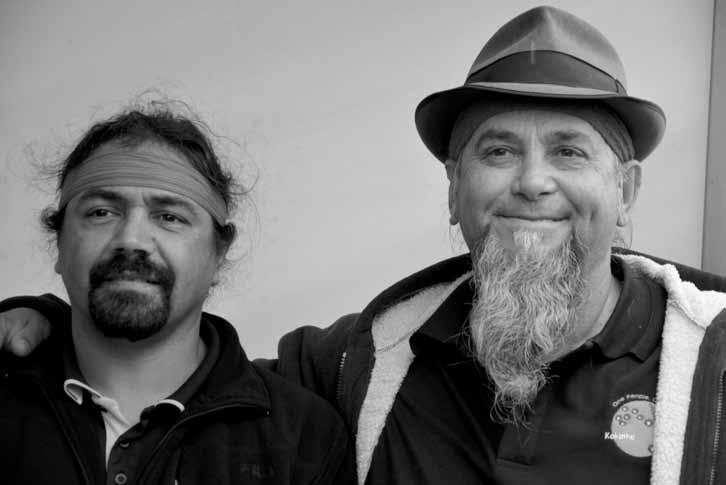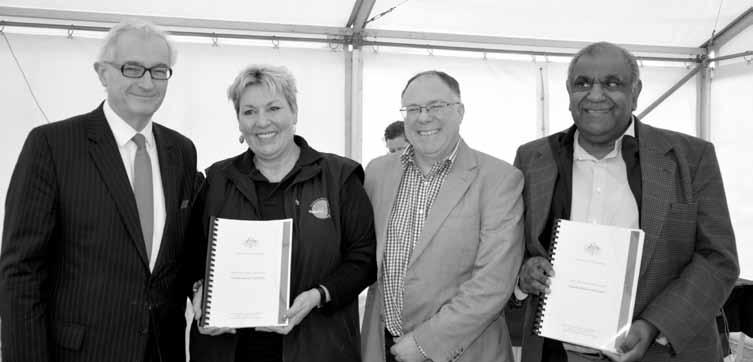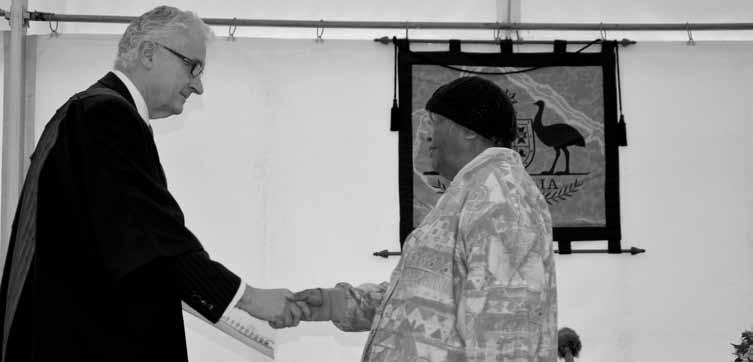
23 minute read
Inside: Tandanya celebrates 25 years
Tandanya celebrates 25 years
Australia’s oldest Aboriginal owned and managed multi-arts centre, Tandanya, celebrated its 25 birthday, last month.
Advertisement
Named after the Kaurna word for ‘place of the red kangaroo’, Tandanya was established following the 1988 Australian bicentennial celebrations after calls for a national centre of Aboriginal arts and culture.
To celebrate the anniversary Tandanya hosted arts and cultural workshops including weaving and painting, throughout the school holidays, and open the galleries and spaces for an evening of entertainment by local Aboriginal artists and musicians.
Tandanya Chief Executive Officer Timothy Ritchie said Tandanya is a vibrant place for people to experience the arts and culture of contemporary and traditional Aboriginal and Torres Strait Islander People.
“Tandanya continues to enjoy a national and international reputation for innovation and excellence in visual art exhibitions,” Mr Ritchie said.
Minister for Aboriginal Affairs and Reconciliation Ian Hunter said “The centre continues to play an important role in supporting Aboriginal economic development,”
Tandanya is owned and managed by the National Aboriginal Cultural Institute Inc.
Tandanya is located at 253 Grenfell Street Adelaide SA 5000 or yarn with Tandanya at tandanya@tandanya.com.au It has been a successful 18 months for South Australian Native Title Services, with a number of significant long-standing native title claims being resolved.
In this period, the native title applications determined were Wangkangurru/ Yarluyandi, Kokatha, Tjayiwara Unmuru, Far West Coast, Adnyamathanha 1 (stages 2 and 3) and the Dieri # 2 claim. That takes the number of native title determinations in South Australia to 23. The Far West Coast application was the largest in South Australia and involved multiple language groups who had combined former separate applications as far back as 1995.
The De Rose Hill compensation application was also determined in October 2013, being Australia’s first successfully determined native title compensation claim. The Native Title Act 1993 (Cth) entitles native title holders to make applications for compensation for any “loss, diminution, impairment or other effect” of certain acts on their native title rights and interests that have occurred since the introduction of the Racial Discrimination Act 1975 (Cth). The consent determination was the final legal step to resolve the State of South Australian’s compensation liability without the need for litigation, and was based on a confidential settlement agreement between the parties.
Also of significance was our successful intervention in Karpany v Dietman in the High Court. Judgment in this matter was handed down on the 6 November 2013. The case was a major test case brought by a Narungga man Owen Karpany who challenged a prosecution by the State Government concerning amounts and size of abalone taken from South Australian waters. The litigation confirmed the applicability of section 211 of the Native Title Act to the State fisheries legislation and associated regulations. The case has set a precedent that native title holders are not constrained by recreational bag limits or size limits, where the take is for the purpose of satisfying their personal, domestic or non-commercial communal needs, and in exercise or enjoyment of their native title rights and interests.
Of note also was the finalisation of a number of settlement ILUAs negotiated at the same time as the consent determinations. These agreements resolve compensation issues between the State of South Australia and the native title holders, and provide for alternative simplified future act regimes.
SANTS has begun to focus its attention to post native title assistance. Currently there are 14 Prescribed Body Corporates (PBCs) operating in South Australia, and SANTS play a key role in supporting their operation, providing services to assist with corporate governance, corporate administration, and legal advice.
SANTS congratulates those who have achieved their native title at this time. We look forward to working closely with native title holders and claimants to realise their aspirations in terms of native title rights and interests.
Merry Christmas from SANTS Keith Thomas, CEO

Keith Thomas.
I am delighted to wish our readers of the Aboriginal Way a very Merry Christmas for 2014. It has been a busy year and, as always, I am grateful for the help and support from all of the staff at SA Native Title Services. Christmas is that time of the year when families and friends get together and share their memories and experiences of the past twelve months. It is also the time when, as an organisation, SANTS can look back on everything that has been achieved throughout the year. I was delighted to attend the Kokatha Consent Determination with a significant number of claimants attending on country at Andamooka Station. It is a tremendous result for the Kokatha people. It also gave me a great deal of pleasure to attend the Wangkangurru/ Yarluyandi Consent Determination in Birdsville. A SANTS Director, Libby Bishop, also attended and represented SANTS most competently at the bench. The site of the hearing was at a location named Pelican Point just out of Birdsville on a peninsula jutting into the billabong. It was an absolutely beautiful location which coincided with great weather to make it a most memorable occasion.
SANTS is also pleased to be assisting PBCs to develop strategies to assist in facilitating their economic, social and cultural aspirations.
Other highlights have been settling the restructure of the SANTS organisation and the complete office refurbishment which has resulted in a more open, lighter office environment. Together with our general work continuing to produce outstanding outcomes for clients, it has been a significant and busy period for SANTS’ staff.
The SANTS Board has continued to provide strong leadership and governance to SANTS. A warm welcome to April Lawrie-Smith, who joined the Board of SANTS as a new Director in November. I look forward to working with her in 2015.
On behalf of the SANTS Board and staff, I wish you all a safe and enjoyable Christmas break with family and friends and look forward to your continuing support in 2015 as we endeavour to achieve the best possible outcomes for our clients.
Federal cuts to South Australia’s remote Aboriginal communities confirmed
The federal Liberal government has confirmed annual funding for municipal and essential services (MES) for South Australia’s regional and remote Aboriginal communities will no longer be provided after June next year. The funding of around 10 million is used for the running of basic services, such as infrastructure maintenance, power, water, food services, rubbish collection and community governance. Indigenous Affairs Minister Nigel Scullion has proposed a final one-off payment of $10 million to transition responsibility for MES to the state.
This equates to only three years of funding for regional and remote communities.
Minister for Aboriginal Affairs and Reconciliation Ian Hunter says South Australia will not be intimidated by the Abbott Government’s decision to unilaterally walk away from its responsibilities to Aboriginal Australians in remote and regional communities. “This offer is insulting and we cannot, in all good faith, even contemplate accepting it,” Mr Hunter said.
“This is an area the Commonwealth Government has been funding and leading for more than 50 years, it cannot now just abandon Aboriginal Australia.”
Under the Commonwealth’s plan, ongoing annual funding of $9.6 million for the provision of municipal and essential services would cease from 1 July 2015. Hon. Ian Hunter said “the State Government plans to fight the Federal government on this cut as the State government is not in a position to make up the money that is being cut”.
“Prime Minister Abbott claims to be the Prime Minister for Indigenous People but this shows that he’s not prepared to stand up for the 4000 Aboriginal South Australians in 60 locations who rely on this funding for provision of everyday services they need and deserve,” said Minister Hunter.
Proposals for reform of the Native Title Act: ALRC calls for submissions
The Australian Law Reform Commission has released a Discussion Paper, Review of the Native Title Act 1993 (DP 82).
The paper contains a range of proposals and questions around connection requirements for the recognition and scope of native title rights and interests; authorisation; and joinder provisions. The ALRC is seeking feedback on these proposals.
Professor Lee Godden, Commissionerin-charge of the Inquiry, said, “The ALRC has relied on more than 100 consultations with Indigenous organisations and individuals, industry, academics, state governments and many other people who are actively involved in the Native Title claims process and we are extremely grateful to everyone who has provided input into our thinking to date. Under the Terms of Reference for the Inquiry, we were to be guided by the Preamble and the Objects of the Native Title Act. In addition, the Inquiry has developed five guiding principles to underlie reforms: acknowledging the importance of the recognition of native title; acknowledging the many interests in the native title system; encouraging timely and just resolution of determinations; consistency with international law; and supporting sustainable futures.
Our proposals seek to improve the operation of the Native Title Act within this principled framework,” she said.
ALRC President, Professor Rosalind Croucher, said, “The Native Title Act is a key element in recognising the relationship of Indigenous people to land and waters. Reforms must also consider the impacts upon all participants in the native title system, as native title operates across many sectors in Australian society.
In this context, the ALRC has had regard to the complexity of law, procedure and practice and the significant policy and economic context for native title. The challenge is to consider change in the native title system that advances the recognition and protection of native title, while ensuring that reforms support a robust and productive relationship between all participants.” The ALRC will now undertake a further round of national consultations and will provide its Final Report to the AttorneyGeneral by the end of March 2015. The Discussion Paper is available from the ALRC website in a range of formats, including as an ebook. All ALRC publications are available free of charge at www.alrc.gov.au/publications.
Repor t into Indigenous disadvantage shows change is possible
A Productivity Commission report on Indigenous disadvantage, released in November this year, provides evidence of both the successes and failures of initiatives to overcome Indigenous disadvantage.
The Aboriginal and Torres Strait Islander Social Justice Commissioner, Mick Gooda and the Co-Chair of the National Congress of Australia’s First Peoples, Kirstie Parker, said the 2014 Overcoming Indigenous Disadvantage (OID) report shows some positive trends, with improvements in health, education and economic outcomes.
“The report provides essential evidence for Government and for policy-makers,” Commissioner Gooda said.
“The evidence of improved life expectancy, significant reductions in child mortality rates and reductions in health risk behaviours during pregnancy show that generational change is possible.
“But the report’s results in areas such as justice and mental health continue to cause concern,” Commissioner Gooda said.
Ms Parker noted that the negative outcomes for mental health and justice demonstrate the difficult, long-term nature of the challenges faced by the Close the Gap Campaign.
“However, we don’t want to be stuck in a narrative of failure,” Ms Parker said. “It is true more needs to be done but dismissing the gains that are being made will undermine the national effort to close the gap.”
Ms Parker and Commissioner Gooda, as Co-Chairs of the Close the Gap Campaign, today called on the Federal Government to demonstrate leadership and drive the national Close the Gap strategy forward by forging a national, coordinated response with the states and territories.
“We welcome the Government’s work to close the gap by implementing a national health plan,” Ms Parker and Commissioner Gooda said.
The OID report shows that for Aboriginal and Torres Strait Islander people:
• Eco n o m ic ou tco m es have i m p roved, with higher incomes, lower reliance on income support, increased home ownership, and higher rates of full time and professional employment.
• Li fe ex pec t a n cy has i m p roved a n d child mortality rates have fallen.
However, rates of disability and chronic disease remain high, mental health outcomes have not improved, and hospitalisation rates for self-harm have increased.
• J us t ice ou tco m es co n t i n u e to d ecl i n e, with adult imprisonment rates worsening and no change in high rates of juvenile detention and family and community violence.
The OID report is produced by the Review of Government Service Provision. It is overseen by a steering committee of senior officials from the Federal, state and territory governments.
Native title recognition for t wo of the oldest claims in SA
continued from page 1
Kokatha Aboriginal Corporation will receive Pastoral leases for the duration of the Olympic Dam Mine which is determined to operate for another 200 years,” he said.
Mr Starkey said the recognition of land is one of the most important aspects of Aboriginal culture.
“My brother and I were lucky enough to have been mentored by a senior lawman from the Western Desert who was responsible for the return of Uluru. He told us you need three things to make a community function as a true tribe; you need your people, your law and land. Today with the granting of the Kokatha consent determination we are again a true tribe, “he said.
Joyleen Thomas, co-applicant of the native title claim, thanked those who have helped to pave the way. “Today is a joyous today for Kokatha, a day for celebration and rejoicing however we have lost many of our precious old people along with way. They fought the good fight for their country but the journey was too long. We thank them for their contribution.”
I would also like to pay tribute to the late Eddie Mabo who fought for over twenty years for recognition and respect for connection to his country. Without Eddie Mabo’s strength and vision, we would not be here celebrating our own milestone. I also pay tribute to the De Rose Hill claim, to the Yankunytatjara people, our kin, who fought with dignity through a litigation process, for the respect and recognition of their law and connection to country. Their achievement of having native title recognised has contributed to the success of other Western Desert claims. We honour them today,” said Ms Thomas.
Mr Starkey said Kokatha are looking to build upon existing relationships and to expand collaborative relationships in the area, including with land and heritage, tourism and defence industries. “It is about putting mechanisms in place to enhance cultural heritage protection, employment and other business opportunities, moving forward,” he said. In addition to the Consent Orders made by the Federal Court, the South Australian Government, the Kokatha and BHP Billiton entered into a historic Indigenous Land Use Agreement (ILUA) in relation to future land use in Andamooka and Pimba.
The IULA provides native title agreement to certain future opal mining operations on the Andamooka Precious Stones Field and future operations associated with the Olympic Dam mine. Minister of Aboriginal Affairs and Reconciliation, Ian Hunter said it is a positive agreement. “It is anticipated these benefits will assist the Kokatha to become key players in the economic, social and cultural development of this region,” Mr Hunter said.







This page, top left: Sandra Wingfield and Lynette Strangways placing. Top right: Michael Turner Jnr and Glen Wingfield signing court documents with Osker Linde (SANTS). Middle left: Michael Turner Jnr with Kokatha native title determination. Middle, centre: Glen Wingfield and Andrew Starkey. Middle right: Professor Roger Thomas. Bottom left: Chief Justice Allsop, Joyleen Thomas, Minister Ian Hunter, and Professor Roger Thomas. Bottom right: Chief Justice Allsop and Barbara Amos.
On 3 October, the native title rights of the Wangkangurru/ Yarluyandi people were also recognised. The determination covers a large area in the far north of South Australia and extending into Queensland including the Simpson Desert. After nearly 20 years of being involved in the native title process, Wangkangurru elder, Don Rowlands, said it was like a dream to have their connection to country finally recognised by a Consent Determination handed down by Federal Court Judge, Justice Mansfield. “After fighting so long, there were times when I thought it was not going to happen, so when the day came, it was a bit surreal and of course, very significant for us and all the families involved. People getting up to receive their copy of the determination was certainly a highlight”, he said. The Federal Court, with the agreement of all parties, made orders over the 60,600 square kilometre area, which includes the Simpson Desert Conservation Park and the Simpson Desert Regional Reserve and parts of the Birdsville Track. The South Australian Government and the Wangkangurru/ Yarluyandi people also signed two significant agreements – a Settlement Indigenous Land Use Agreement and Parks Indigenous Land Use Agreement – that recognise the rights of the traditional owners over land, including parks within the South Australian part of the determination area.
Aboriginal Affairs Minister Ian Hunter said it was a historic day for the Wangkangurru/ Yarluyandi people.
“Today’s decision is an acknowledgement of an important part of our nation’s history.
“The native title determination recognises that the Wangkangurru/ Yarluyandi people have had an ongoing connection with this land, which has been their spiritual and physical home long before European settlement in Australia. Important customs and knowledge in relation to the land have been passed down through generations and are retained by people today,” said Minister Hunter.
As part of the native title ceremony, ancestral remains were repatriated to the Wangkangurru/ Yarluyandi people for proper burial. Traditional Owner Raymond Finn said as part of the ceremony at Pelican Point “we are celebrating the life of the two men and bringing them home,” he said.
Mr Rowland said it is important to remember that many generations have connection to the land.
“For me one of the most important things is that we recognise the generations of the pioneer families, and I can mention the Brook Family here, to understand that we all have deep connection to the country, and to appreciate that we all care for this land.” Mr Rowlands said the community is feeling positive about the future; “it is time to get to work and keep an eye on the country and the mining developments. We will be on the ball and ready to negotiate collectively and plan wisely for our future, “he said. Keith Thomas, South Australian Native Title Services CEO, congratulated both native title groups for their success. “I applaud the efforts of the Kokatha and Wangkangurru/ Yarluyandi people for their determination and fight to get them where they are today. Although it has been a hard slog, the sheer commitment to the native title process and efforts made by their leaders, has meant a successful outcome for both claim groups, and for that I could not be happier. “
SANTS Accident
In October 2014, three SANTS employees were injured during a car rollover when returning from the Birdsville Consent Determination. SANTS would like to thank everyone who supported and helped our employees following the accident. We would like to advise that all three of our employees are recovering well and have returned to work.







This page, top left and centre: Native title holders at Wangkangurru/ Yarluyandi CD. Top right: Pelican Point, Birdsville. Middle left: Native title holders and participants at Wangkangurru/ Yarluyandi CD. Middle right: Native title holders displaying celebration shirts. Bottom left: . Bottom right: Pelican Point Billabong, Diamantina River, Birdsville.
Everyone at Vibe is extremely proud and humbled by the work we do on behalf of the community and of the support we receive from community, and the wider Australian public. This announcement is made in good faith to inform you of the current situation.
The Vibe Project includes:
• Dead l y V i be ma gazi n e • T h e Dead l ys • I nV i be ma gazi n e • Dead l y Sou n ds rad io • M ove I t M o b S t y le T V • deadl y v ibe.com.au (also as a value added activity, Deadly Vibe on
Facebook and Twitter sites and the weekly e-publication Deadly Vibe Wire). As of 30 June 2014 all these activities are concluded. However, our commitment to Vibe and our belief in the work we do on behalf of community remains firm.
The annual Deadly Awards® were due to be held at the Sydney Opera House on 30 September 2014 but did not go ahead. We understand we have responsibilities to a number of sponsors and will be in negotiation with these agencies and organisations over coming weeks, and will negotiate and honour such responsibilities.
Everyone at Vibe stands by our work, across our events and communications activities, and are confident in our ability to improve the health and wellbeing of Aboriginal and Torres Strait Islander Australia through our holistic approach in primary health, mental health and social and emotional wellbeing and across education, employment and community empowerment.
We have always had in our hearts a goal of strengthening the connection to culture and community. Through all our work, we are proud to bring you the excellence and achievement, to create unity and rightful pride in identity of Aboriginal and Torres Strait Islander people, particularly for our young people.
We are proud of all we have achieved with our radio program, Deadly Sounds, Deadly Vibe magazine, InVibe magazine, Move It Mob Style®, our Vibe 3on3® events and of course, The Deadlys® .
Move It Mob Style® Series 4 has been completed, and commences on NITV and ABC3 soon.
Going forward, at this point, there are many responsibilities that we have to partnerships and working relationships. And we will be calling and working through these as quickly as possible. We ask everyone to please be patient.
We would like to thank everybody who has been a part of Vibe to this point over our 20 year journey and ask for your support at this critical time.
We would also like to thank the Australian Government, and the many officers and political people along the journey, for having the insight and vision to support Vibe for so many years.
Since the early 1990s, we hope we have contributed greatly to empowering Aboriginal and Torres Strait Islander people all ages, particularly the young, to be their best with regard to education, employment, health and wellbeing, by providing clear and coherent information and showcasing positive role models, advancing the individual, the family, and the community.
Thank you, and in unity, Vibe Australia
For the second consecutive year Jessica Mauboy has been awarded the NIMA for National Artist of the Year.
Due to her outstanding accomplishments both here and abroad, the news came as Jess is recording her new album in Los Angeles where she delivered her acceptance speech from to the crowd.
Dan Sultan continues his rise taking out National Album, Song and Cover Art of the Year.
Having just concluded a sell out Australian tour Dan is now preparing for shows in London, New York and LA next month.
The “Unofficial Mayor of Shepparton” Briggs was awarded the NIMA National New Talent Award. A timely award considering his new album Sheplife is out next week on 22 August. His win tips the scale for a victorious Victoria collectively garnering four of the seven national awards.
National Film Clip of the Year went to North East Arnhem Land band East Journey who are currently in rehearsals with Yothu Yindi for a 2015 concert tour. Film makers Naina Sen and Susan Sandery collected the award for this stunning piece of work that is both visually and culturally compelling.
The National Community Clip of the Year acknowledges the role that music and new media plays in spreading positive messages throughout Indigenous communities. This year the NIMA went to Fly Back Home by artists Desert Sevenz from the remote NT community of Ampilatwatja.
NT Traditional Music Award of the Year goes to two acts: Lindsay Gameraidj [Bininj Band] for his song Nangale Nuk ; a strong message about eating local food/traditional food. Also awarded in this category is Jaydron Nundhirribala, Roland Nundhirribala and Grant Nundhirribala for maintenance of traditional performance.
NT School Band of the Year goes to those with the delightfully ambitious moniker the Rockstar Band. This nine-piece outfit from Gapuwiyak are becoming somewhat of a festival favourite at remote community Gapuwiyak and Garma Festivals, and took out second place at the Northern Territory Music School songwriting competition in 2013.
And last but certainly not least comes the announcement that Munkimuk aka Mark Munk Ross’ contribution to the music industry was recognized with an induction into the NIMA Hall of Fame.
“MusicNT is immensely proud to be presenting the 2014 NIMAs. The Awards have played an instrumental role in shining a light on the scene and providing a national platform for recognition. One of the highlights is the diversity of this year’s line-up which truly showcases the breadth of talent across the Indigenous Music Industry, and audiences are recognising this with our highest ticket sales to date. The Indigenous music scene is a force to be reckoned with and the finalists in this year’s awards are the flag bearers of this next wave of success. MusicNT extends its congratulations to all the winners.” Mark Smith, Executive Director MusicNT; organisers of the NIMAs
The National Indigenous Music Awards were held in Darwin on Friday 15 August. Famous local legends The Mills Sisters opened with a Welcome to Country and sung in NIMA 2014 with their tropical hit Ararfura Pearl. TV personality Aaron Pedersen perfectly played the MC for the night, Dan Sultan headlined with his full band including horn section. One of the highlights of the night was the Hip Hop Showcase hosted by Nathan Lovett-Murray [Payback Records] featuring New Talent of the Year Briggs joined by Jimblah, The Last Kinection and the NIMA 2014 triple j Unearthed NIMA Competition winner Philly who performed his new single We On [digitally release now via iTunes]. Tom E. Lewis, Tjintu Desert Band, the Desert Divas and multiple vignette performances by Djuki Mala [aka Chooky Dancers] all came together to make this another outstanding culturally rich event held under the beautiful Darwin dry season sky.
This year thanks to TEABBA, CAAMA and CRN the NIMAs was broadcast live via the Community Radio Network [CRN/CBBA] making it available to over 1.2 million listeners nationally.
The National Indigenous Music Awards celebrate traditional and contemporary artists from around the country and this year truly show the strength of Indigenous music across the country. 2014 National Indigenous Music Award winners
National Artist of the Year Jessica Mauboy
National Album of the Year Blackbird – Dan Sultan
National Song of the Year The Same Man – Dan Sultan
National New Talent of the Year BRIGGS
National Cover Art of the Year Blackbird – Dan Sultan Artist – Ken Taylor
National Film Clip of the Year Bright Lights Big City – East Journey Director/Film Maker – Naina Sen Executive Producer – Susan Sandery
Community Clip of the Year Artists – Desert Sevenz Song – Fly Back Home Community – Ampilatwatja, NT Released – Sep 25, 2013 Facilitators / Mentors of Project – Desert Pea Media
NT School Band of the Year ‘Rockstar Band’ A nine piece outfit from Gapuwiyak, NT



